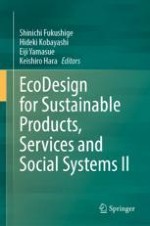Abstract
Air conditioners (ACs) are indispensable in our daily lives. It is expected that the demand for ACs will continuously increase across the globe, particularly under the Covid-19 epidemic, where the effective utilization of household AC is attracting attention. As the demand for ACs increases, there is a critical concern about environmental problems due to the incremental energy consumption. Many studies have analyzed the environmental burdens of ACs by using the life cycle assessment. Greenhouse gas emissions were primarily focused so far, whereas few have been analyzed from the viewpoint of resources. The focus on resource use is important since addressing the resource-related issues (i.e., depletion of critical metals) is challenging in recent years. In practice, there is a probability that a large volume of various resources is consumed under the production of AC because of technological innovation in energy efficiency. Therefore, the purpose of this study is to evaluate resource use throughout the AC life cycle. Among various indicators for resource use, this study focused on total material requirement (TMR). TMR is considered as a most comprehensive indicator for resource use, involving direct resources, indirect resources, and the accompanying unused mine wastes related to hidden flows.
The system boundary in this study covered the manufacturing stage and the usage stage in Japan. Fifteen types of home ACs manufactured between 2002 and 2019 were analyzed. The TMR of ACs at the manufacturing stage was obtained on the basis of the composition analysis. The TMR of ACs at the usage stage was obtained by calculating the amount of electricity consumption, where the electricity mix of 2018 was utilized.
As a result, it was found that the TMR of the production of assessed ACs are in the range of 1686–4680 kg-TMR. Notably, under the manufacturing stage, the TMR of copper, which has a great mining intensity, accounts for more than 70% of ACs. The TMR of ACs at the manufacturing stage per heating and cooling capacity has slightly increased from 2002 to 2019. This is because of the slight increase in the usage of copper for the heat exchanger. From this, it can be seen that energy efficiency has increased but resource efficiency has not.
This study further compared the TMR of the high-performance model (hereinafter, Model-H) and consumer model (hereinafter, Model-C) of ACs from the perspective of resource payback time (RPT). Considering that Model-H has a higher annual performance factor (APF), which is one of the indicators of energy efficiency, and TMR under the production stage than Model-C, the RPT is defined as the breakeven point where the TMR of Model-H overtakes the TMR of Model-C. The RPT varies depending on the operational condition in the household. For instance, based on the study by Japan Center for Climate Change Actions, the RPT of the Model-C and the Model-H manufactured in 2018 in a living room and a children’s room was 6.64 years and 38 years, respectively. Since the average domestic service life span of Japanese air conditioners is 14 years, it is desirable to use the Model-H when using it in the living room, while a Model-C is preferable when using it in the children’s room. In this way, it is possible to select the optimum air conditioner from the viewpoint of resources according to the operating conditions of ACs.
